
|

|
 |
|
MEDICINE FROM NATURE |
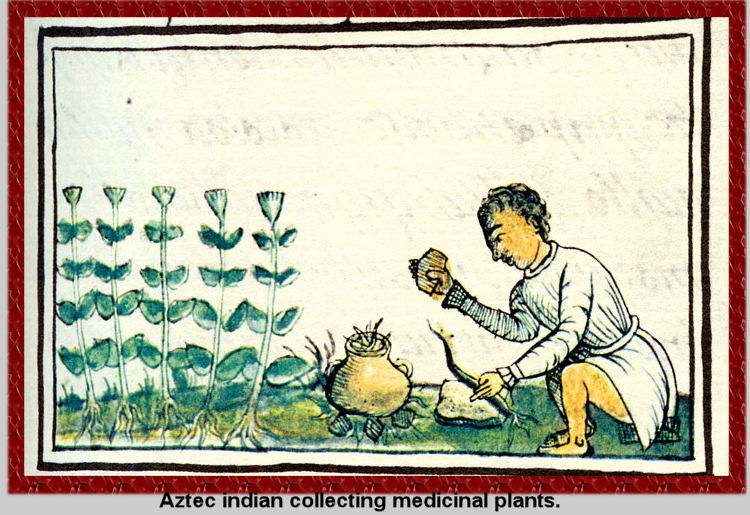 Plants and herbs have been used to treat diseases going back at least 65,000 years!
Plants and herbs have been used to treat diseases going back at least 65,000 years!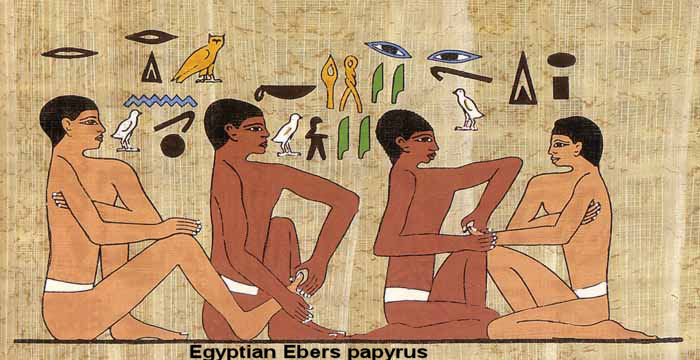 The first known written records of the use of medicinal plants; done by the Egyptians, Aztecs, Incas and
Sumerians;
date back at least 5,000 years.
The first known written records of the use of medicinal plants; done by the Egyptians, Aztecs, Incas and
Sumerians;
date back at least 5,000 years. Especially the Egyptians had a rational and scientific approach to medicine as was written in The Edwin Smith Papyrus, an ancient
Egyptian medical text, probably from 3,000 – 2,500 BC.
Especially the Egyptians had a rational and scientific approach to medicine as was written in The Edwin Smith Papyrus, an ancient
Egyptian medical text, probably from 3,000 – 2,500 BC.
Civilizations in India and China still relay, after many thousand of years, for a great part on herbal medicine. 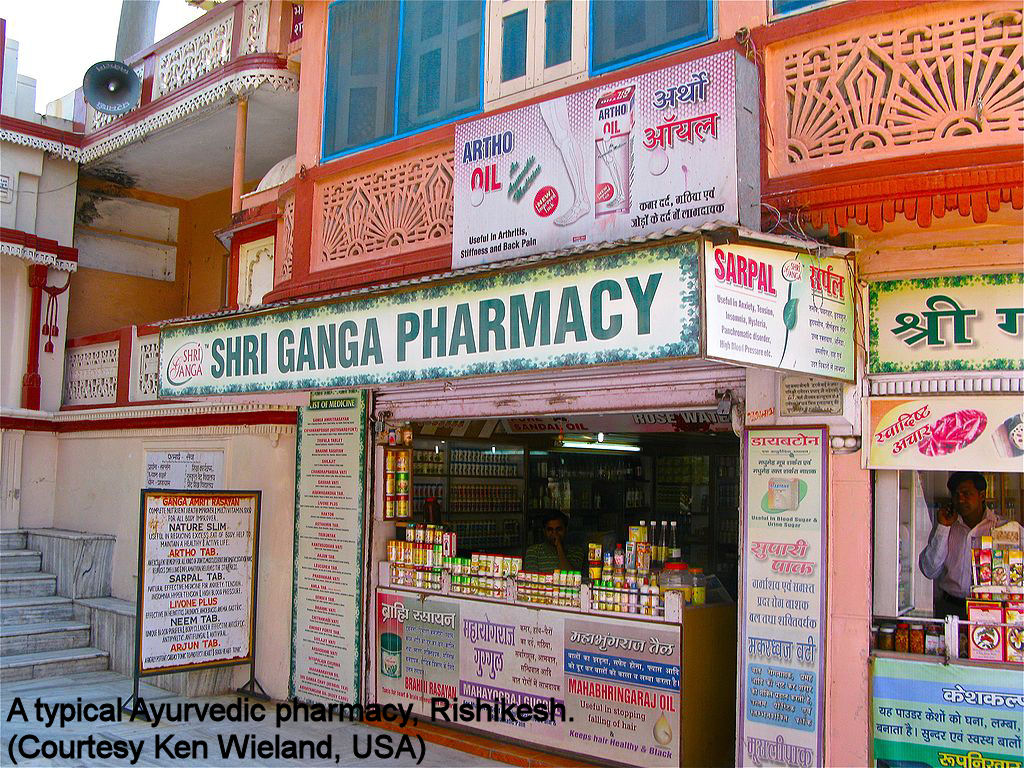 Traditional Chinese Medicine and Ayurvedic (the ancient East Indian system of health care) are many thousands of years old
but still very relevant today.
Traditional Chinese Medicine and Ayurvedic (the ancient East Indian system of health care) are many thousands of years old
but still very relevant today.However there also are more old and tried medicinal systems. Take Jamu for instance (the ancient Indonesia system of health); the used plants and herbs stimulate the body’s immune system to produce antibodies). Using medicinal plants is not something of the past or old fashioned; on the contrary. The far greater part of the world's population up to this day, relies heavily on plant material; herbs and extracts as medicines. According to estimates of The World Health Organization (WHO), 80 percent of the world’s population still uses traditional remedies, plants included, as the primary health care. Matter of fact, at least 25% of today's pharmaceutical drugs still have plant ingredients and/or (synthetic) derivates from these. Among the 120 active compounds currently isolated from higher plants and extensively used in modern medicine today, 80 percent show a positive correlation between their modern therapeutic use and the traditional use of the plants from which they are derived. However, modern medicine as we know is moving away from plants as the core of its medicines.  The total number of plants worldwide is unknown, new species are still being identified.
The total number of plants worldwide is unknown, new species are still being identified.There are an estimated 310,000 to 422,000 plant species on earth and many have or may have medicinal applications. 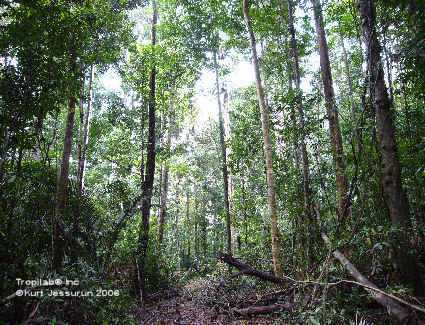 There is widespread destruction of tropical rainforest ecosystems and extinction of numerous plant and
animal species happening
at this very moment everywhere on earth; especially in the tropics.
There is widespread destruction of tropical rainforest ecosystems and extinction of numerous plant and
animal species happening
at this very moment everywhere on earth; especially in the tropics. The consequence may be that in the future fewer medicines against diseases such as cancer and HIV are being developed. In this century, between 94,000 and 144,000 species are at risk of dying out and many of these have not yet been named! According to a report published recently in the journal Science, between 22 and 47 percent of the world's plants are endangered. However unfortunately, botanists have still not compiled and catalogued many plant species. For many thousands of years plants have been the major source of medicine for mankind. Many of today's useful drugs find their origins in the earliest medical plant folklore. For instance think of quinine (from Peruvian bark), morphine (from opium poppy), atropine (from deadly nightshade) and many others. China and India among others have a very long and old tradition in the use of plants against many ailments and diseases. In the Amazon rainforest, many plants and herbs also have been used for thousands of years to cure, treat and prevent many illnesses and diseases. This practice continues up to the present day. Modern research also has unlocked many new applications. Many potent phytochemicals (chemical compounds occurring naturally in plants) have been identified and are used as such in treatments. 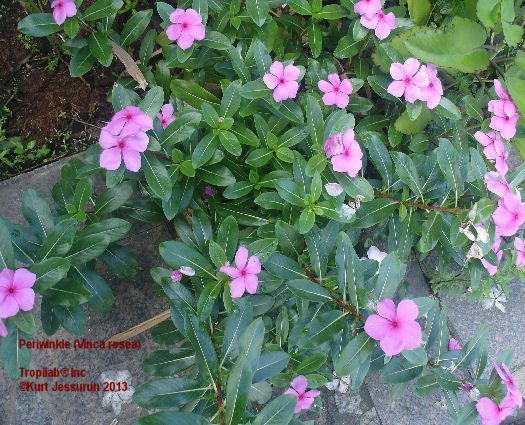 For instance, this can be seen in the use of the Rosy Periwinkle (Vinca rosea) from Madagascar
against childhood
leukemia (the most common type of cancer in children and teens).
For instance, this can be seen in the use of the Rosy Periwinkle (Vinca rosea) from Madagascar
against childhood
leukemia (the most common type of cancer in children and teens).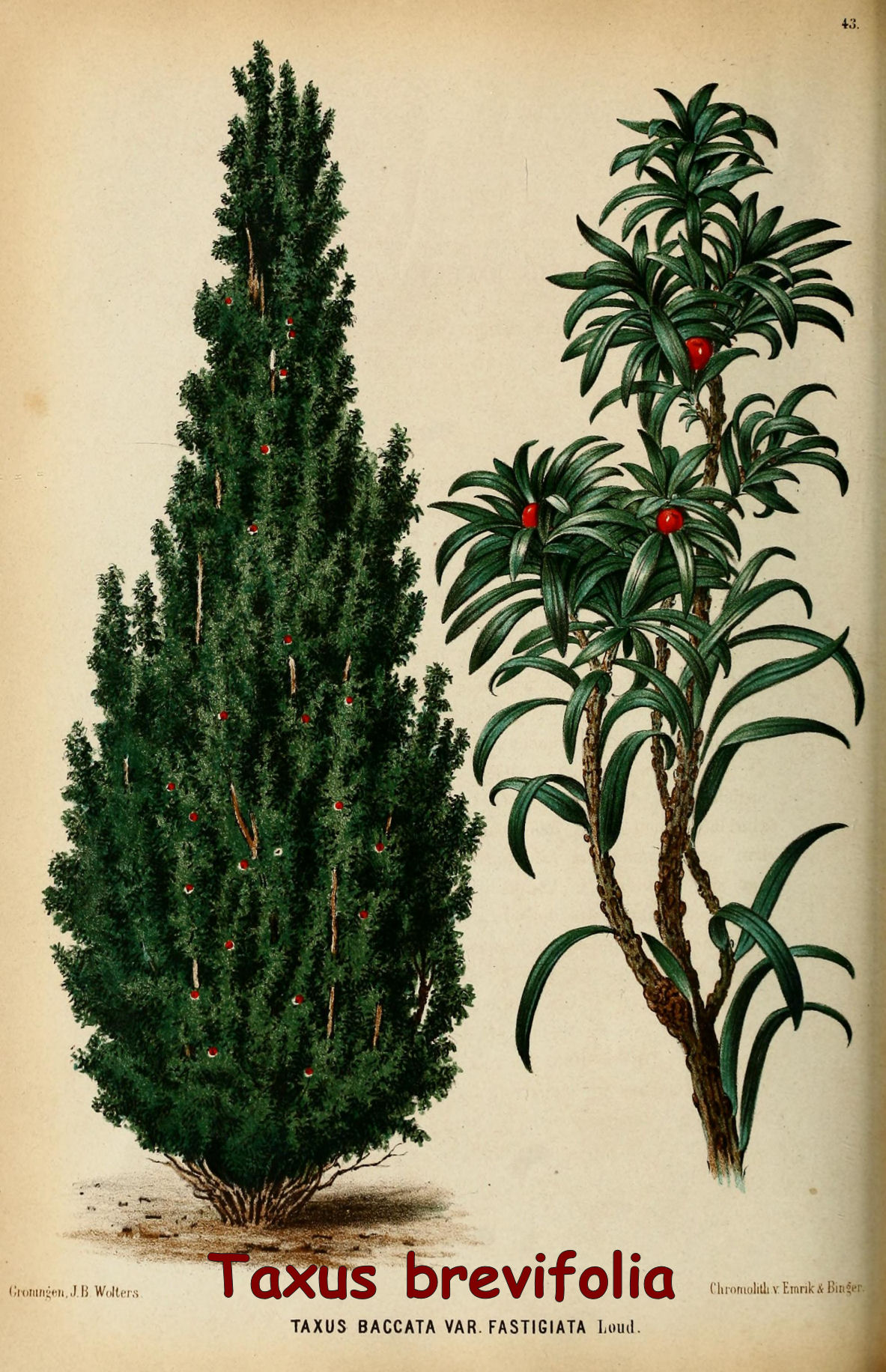 Also the use of Taxol (Paclitaxel), derived from the bark from Pacific Yew tree (Taxus brevifolia) against several
types
of cancer.
Also the use of Taxol (Paclitaxel), derived from the bark from Pacific Yew tree (Taxus brevifolia) against several
types
of cancer.There are many more examples of the use of botanicals in modern medicine such as an enzyme from the Papaya (Carica papaya) that helps to shrink or dissolve ruptured disks in the spine. 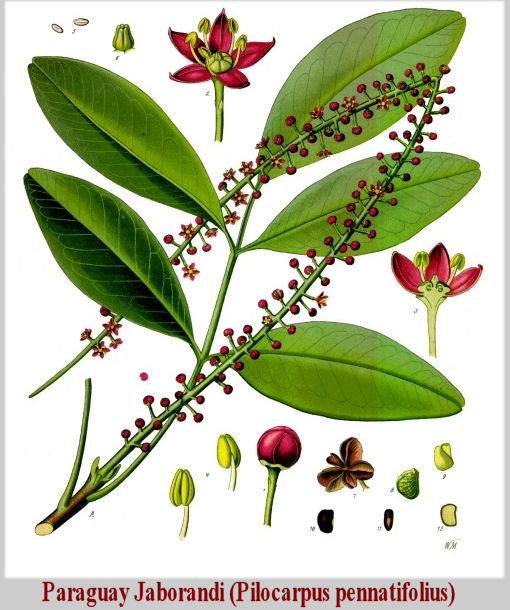
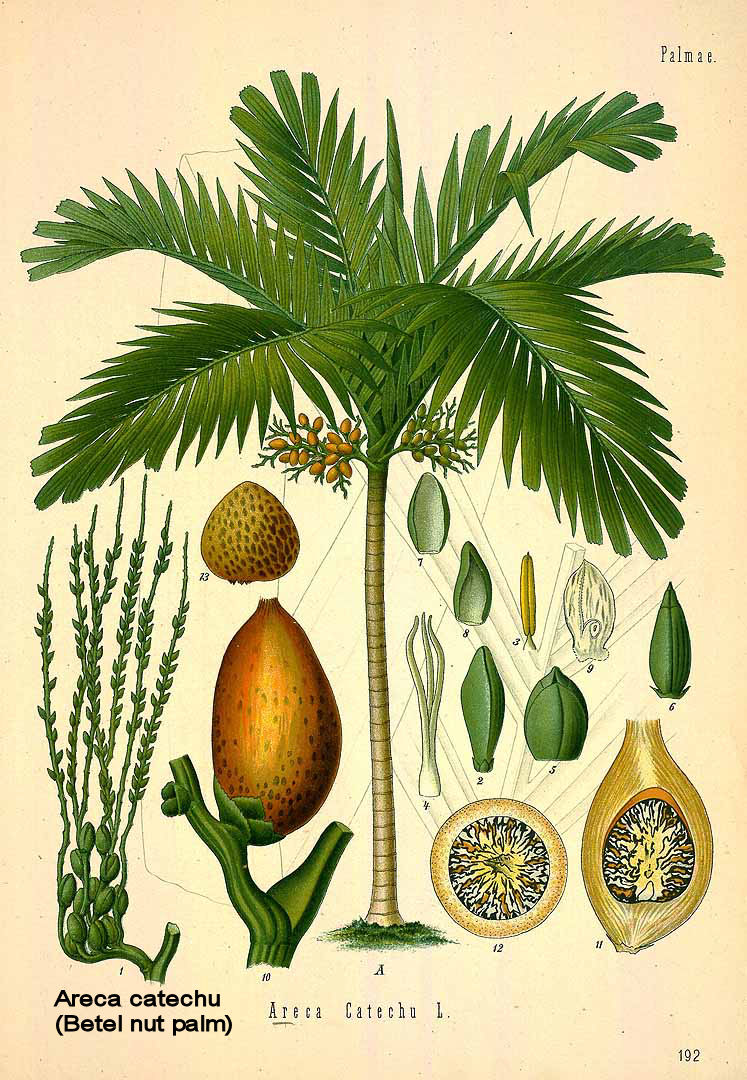 Pilocarpine (from the Pilocarpus shrub in the Amazon rainforest) and Arecoline from the Betelnut (Areca catechu) to treat glaucoma. Capsaicin from Cayenne pepper (Capsicum fruticosum), to treat the pain of arthritis, shingles and nerves. 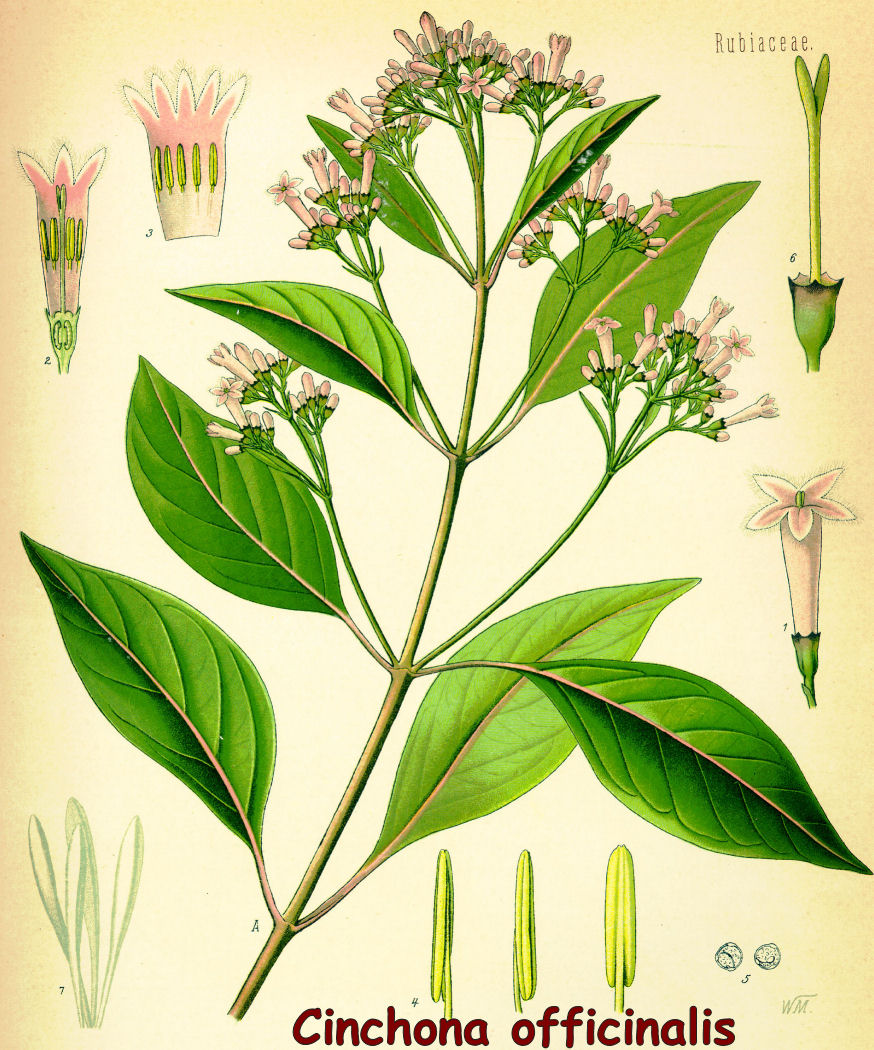 Quinine, used as a cure for malaria, is extracted from the bark of the cinchona tree.
Quinine, used as a cure for malaria, is extracted from the bark of the cinchona tree.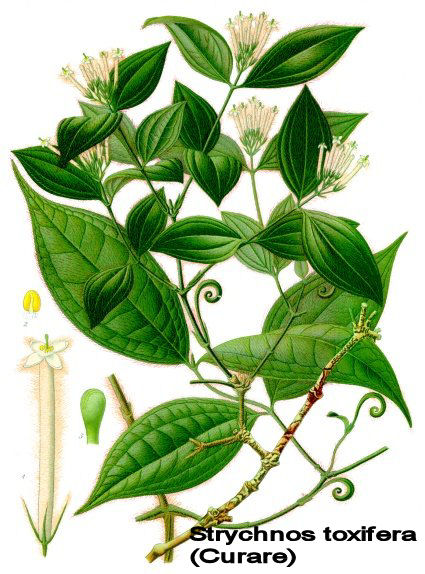 Curare (from which d-turbocuarine is isolated) and that is used as a general anesthesia and to
treat muscular disorders.
Curare (from which d-turbocuarine is isolated) and that is used as a general anesthesia and to
treat muscular disorders.The cancer treatment drug Topotecan is extracted from Camptotheca (Happy tree). Coumadin from the seeds of the Tonka tree (Dipteryx odorata,) an Amazonian rainforest tree, that is used as a blood thinner. 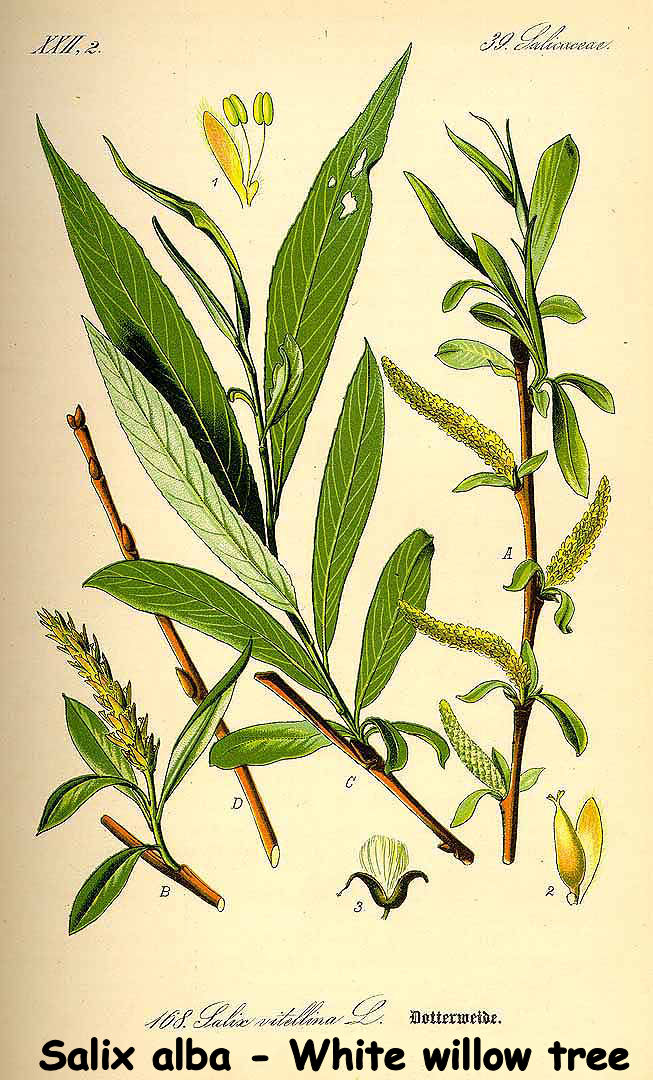 Aspirin (acetylsalicylic acid) used against fever, pain, rheumatic fever, and inflammatory diseases. It also has an antiplatelet
effect; decreases the ability of blood clots to form. The active ingredient was first discovered from the bark of the willow tree (Salix)
in 1763. The origin of aspirin is somewhere between 460 BC - 377 BC, when Hippocrates, the famous Greek doctor, prescribed chewing
on the bark of the willow tree to reduce fever and pain.
Aspirin (acetylsalicylic acid) used against fever, pain, rheumatic fever, and inflammatory diseases. It also has an antiplatelet
effect; decreases the ability of blood clots to form. The active ingredient was first discovered from the bark of the willow tree (Salix)
in 1763. The origin of aspirin is somewhere between 460 BC - 377 BC, when Hippocrates, the famous Greek doctor, prescribed chewing
on the bark of the willow tree to reduce fever and pain.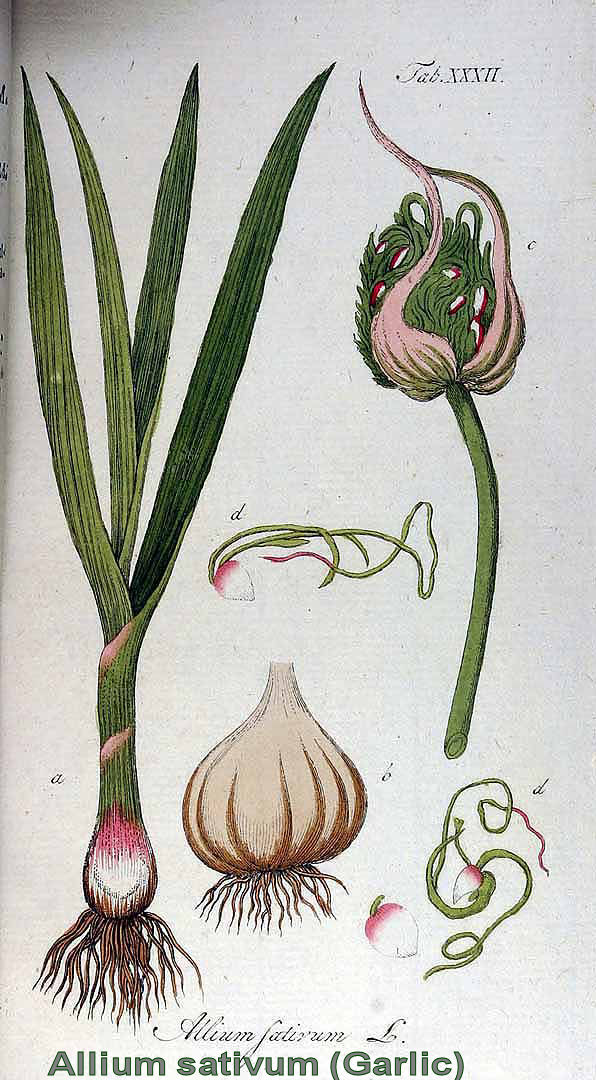
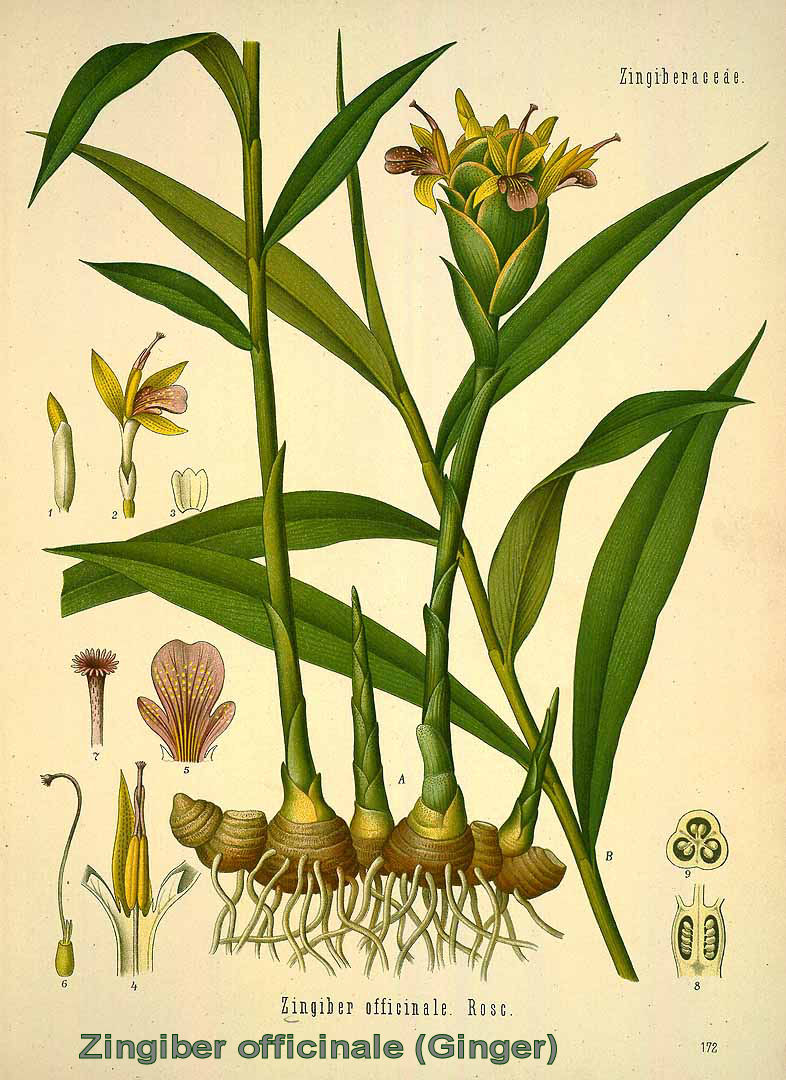 Also the “humble” Garlic, the closely related Onion and Ginger have many interesting and very useful medicinal
properties, as we will see later on.
Also the “humble” Garlic, the closely related Onion and Ginger have many interesting and very useful medicinal
properties, as we will see later on.The list can go on and on but still too many plants, herbs, mosses and fungi are not utilized in mainstream medicine for a number of reasons. Using plants and herbs in the treatment of diseases and illnesses is almost universal among emerging markets and Third World countries; they often are more affordable than buying expensive pharmaceuticals (refined or synthesized drugs). Unfortunately, the trend is moving away from natural substances and more to rely heavily on synthetic drugs. A few of the reasons why this is occurring may be due to the following: The most important reason though why relatively few plant based medicines have been utilized in main stream medicine in the last 100 years is the fact that patenting plant compounds is very difficult to do. However, for a few decades now, there has been renewed (although not general) interest in reusing medicinal plants in western medicine. Some of the reasons can be; the need for alternative treatments for drug- resistant pathogens and the existence of ailments without an effective pharmaceutical treatment. |
|
PHYTOCHEMISTRY OF PLANTS |
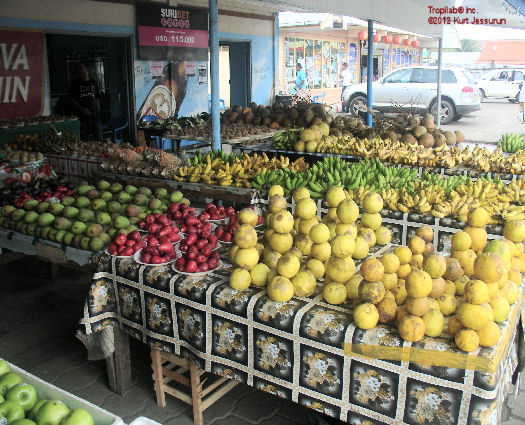 Plants synthesize an enormous variety of phytochemicals.
Plants synthesize an enormous variety of phytochemicals.These are all products of the primary metabolism of the plant (such as sugars and fats), the chemical reactions involved in maintaining the living state of the cells and the organism. Plants also synthesize additional components of which the main groups are alkaloids, polyphenols, terpenes and glycosides. 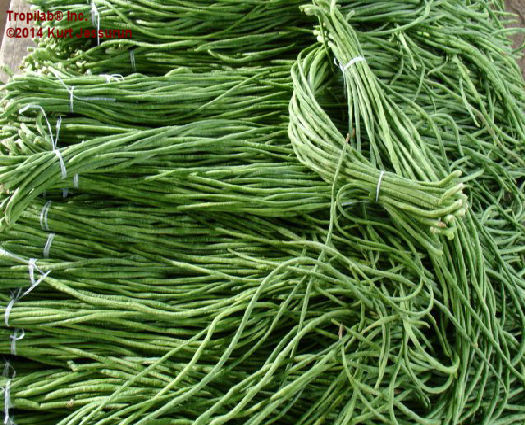 These are called secondary metabolites; they protect the plant against fungi, bacteria, animals, insects
and other
hostile plants.
These are called secondary metabolites; they protect the plant against fungi, bacteria, animals, insects
and other
hostile plants.The medicinal effects of plants are a result of the combination of secondary metabolites that are present in it. It is estimated that as many as 10,000 different phytochemicals potentially may affect diseases. 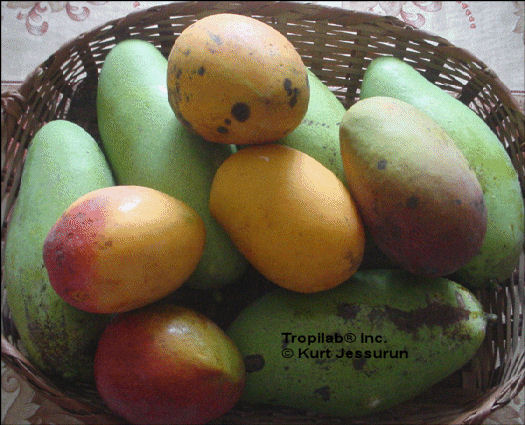 Although
there are far more, many have not yet chemically been characterized.
Although
there are far more, many have not yet chemically been characterized.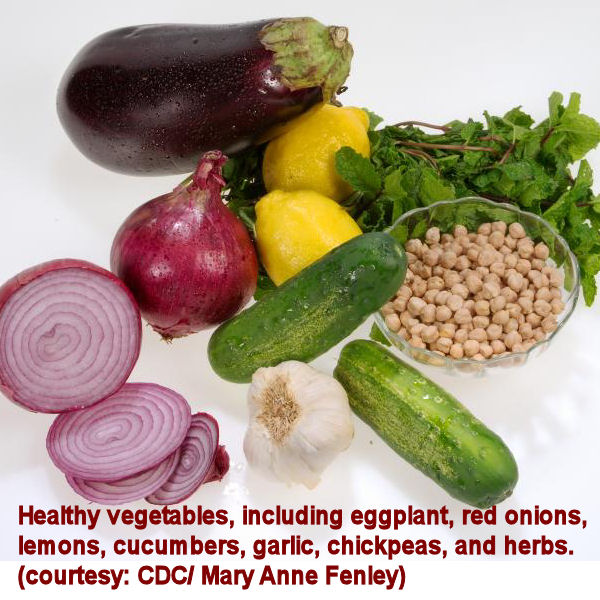 There is clear evidence that the many phytochemicals in fruits and vegetables may reduce the risk of cancer, heart attacks and strokes.
There is clear evidence that the many phytochemicals in fruits and vegetables may reduce the risk of cancer, heart attacks and strokes.These phytochemicals in freshly harvested plant foods can be destroyed or even removed by some processing techniques such as cooking. Fruit and vegetables also contain vitamins, such as A, C and E as well minerals such as calcium and zinc. |
|
HERBAL MEDICINE |
|
This medical treatment is based on plants throughout history
and this tradition is still practiced up to
this day in most parts of the world.
Plants are used for medicinal purposes;
however, it is not only strictly based on evidence gathered using
scientific methods. A more scientific approach is done by phytotherapy that works only with modern standards of effectiveness testing herbs and medicines, derived from natural sources. 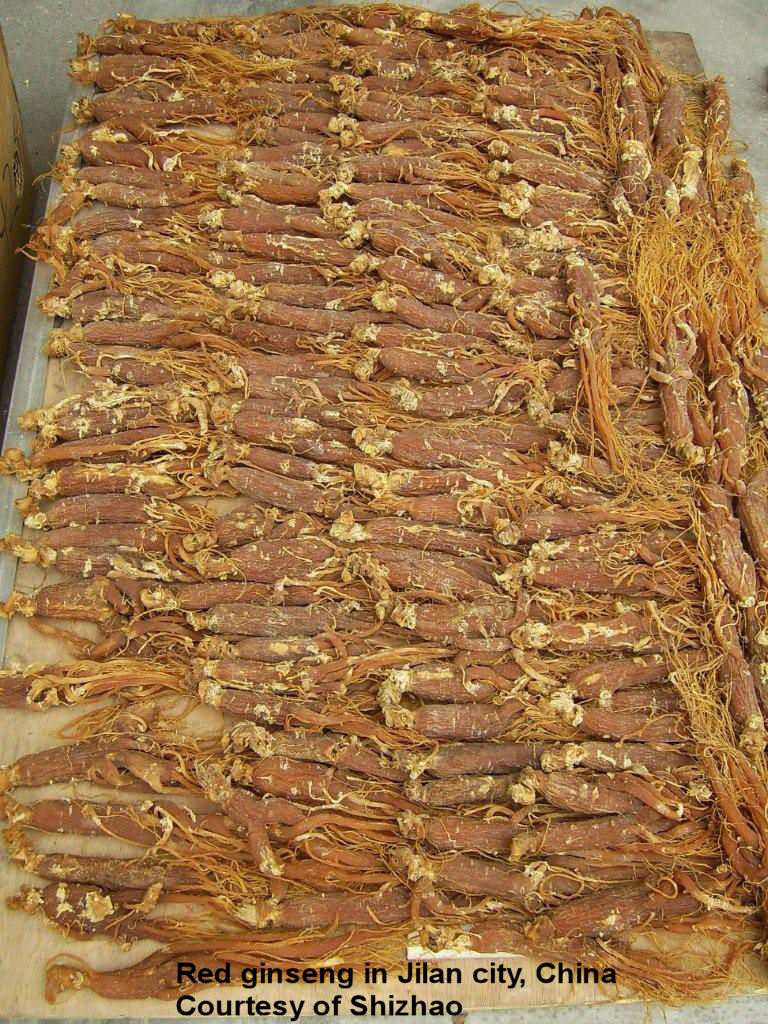 It can be considered as the study on the effects and clinical use of herbal medicines.
The medicines used in phytotherapy
differ from plant-derived medicines in standard pharmacology.
It can be considered as the study on the effects and clinical use of herbal medicines.
The medicines used in phytotherapy
differ from plant-derived medicines in standard pharmacology.In phytotherapy, the complexity of substances from plants is preserved with relatively less processing while standard pharmacology (the working of medicine in the body) focuses on isolating active compounds from plants. Traditional phytotherapy is synonymous for herbalism; besides the approach to scientific methods other means such as historical and traditional knowledge, are also incorporated. Traditional knowledge can guide the selection of optimal dose, species, time of harvesting and target population.  Herbalists use extracts from parts of plants, such as roots stems, bark, flowers and leaves but do not
isolate
particular phytochemicals.
Herbalists use extracts from parts of plants, such as roots stems, bark, flowers and leaves but do not
isolate
particular phytochemicals.Pharmaceutical (allopathic) medicine prefers single ingredients citing that the dosage this way can be more easily quantified. However, isolating plant compounds may change or destroy the medicinal effect. Herbalists often reject the idea of single active ingredients; they argue that the different phytochemicals present in many plants will interact to enhance the therapeutic effects of the plant and dilute possible toxicity. The phytochemical interactions and trace components present in plants can alter the drug response (in the body) in ways that cannot be replicated with a combination of a few isolated active ingredients. The many phytochemicals in the plants exert therapeutic effects; more than any single compound alone can do. Claims of synergy and multi-functionality have been supported by science; synergism plays an important role in therapeutic efficacy of plants. In many cases additional substances in the plant, enhance activity of the components actually responsible for this synergistic effect. We at TROPILAB® make use of all available sources in standard and ethno-pharmacology, modern and traditional phytotherapy for further research and applications of plants and extracts against illnesses and diseases. |
|
MEDICINAL PLANTS IN SURINAM |
|
Being an intrinsic part of the Amazon rainforest,
many of the indigenous plants from
Surinam
However, due to large floods of immigrants from other parts of the world, many plant species not indigenous to this country are now also growing abundantly in Surinam. In this website we describe how plants from Surinam can be utilized and applied in the treatment of many illnesses and diseases. Traditional Surinam medicine (locally called Oso Dresi), includes for the most part native Amazonian elements, but also imported ones, like those from Africa and Southeast Asia namely India and Dutch East Indies (today’s Indonesia). Many plants used in traditional medicine from India (Ayurvedic medicine) and Indonesia (Jamu) are part of the Osodresi. There is growing interest in Surinamese medicine since the country is virtually located right in Amazon rainforest which is home to an immense biodiversity of plants, animals, amphibians, insects and fungi. The traditional use actual means that countless trial-and-error tests have been conducted over the centuries by South American Indians and Maroons. All this points the way to natural therapeutic use of plants. Indigenous uses of plants by Surinam traditional healers, have a high success rate and as such often lead to unexpected leads for further research. Present research of plants, used for ages as medicine, brings more and sometimes surprising results and applications to light. However there is no magic bullet for diseases as is suggested in the film Medicine man with Sean Connery but rather hard work and scientific research. There are more than 1,200 plants that are used against numerous diseases and most of those plants have more than one working. |
|
THE AMAZON RAINFOREST |

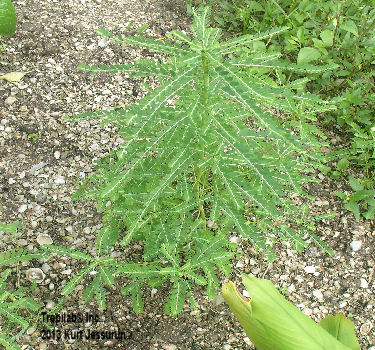 Let us now embark on a tour through the Amazon rainforest and check on some of the plants used
for a wide array of illnesses and
diseases.
Let us now embark on a tour through the Amazon rainforest and check on some of the plants used
for a wide array of illnesses and
diseases.We will find humble plants such as Chanca piedra (Phyllanthus species); growing abundantly in the plain costal area to lianas (woody vines), to the mighty Kapok tree (Ceiba pentandra), growing deep in the rainforest. 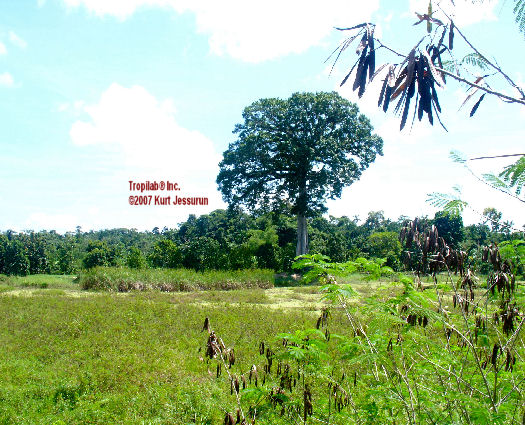 These plants are all employed in phytotherapy; Chanca piedra is used against liver and kidney ailments
as well urinary tract and
bladder infections. Moreover, it works excellent against hepatitis.
These plants are all employed in phytotherapy; Chanca piedra is used against liver and kidney ailments
as well urinary tract and
bladder infections. Moreover, it works excellent against hepatitis.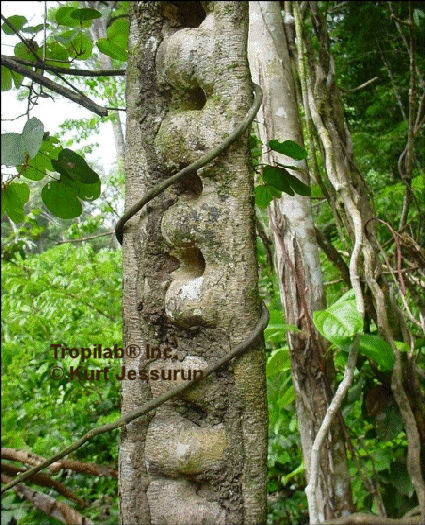 Lianas such as Abuta (Cissampelos pereira) and
Dobrudua (Strychnos melinoniana) are used
respectively against women's ailments and as a powerful aphrodisiac.
Lianas such as Abuta (Cissampelos pereira) and
Dobrudua (Strychnos melinoniana) are used
respectively against women's ailments and as a powerful aphrodisiac.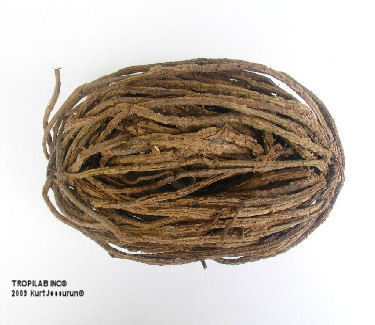 The biggest tree of the Americas, the Kapok tree, is used against fevers, dysentery and venereal diseases.
The biggest tree of the Americas, the Kapok tree, is used against fevers, dysentery and venereal diseases.
There are a number of dangerous tropical diseases* such as malaria and leishmaniasis. Against the malaria, Surinam bitterwood (quassia amara) can be used and for the latter one Mullaca (physalis angulata) and Epazote (Chenopodium ambrosioides) are available. 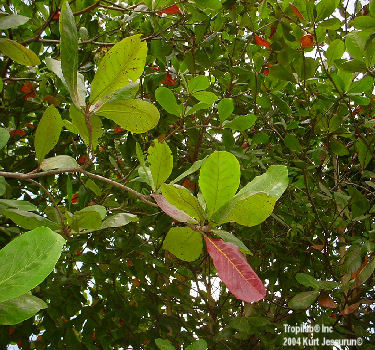 And than there are also not indigenous medicinal plants originally from South-east Asia, such as the
Tropical almond
(Terminalia catappa), which is now growing abundantly in Surinam.
An extract from the fallen red leaves can be successfully used
again liver ailments such as cirrhoses.
And than there are also not indigenous medicinal plants originally from South-east Asia, such as the
Tropical almond
(Terminalia catappa), which is now growing abundantly in Surinam.
An extract from the fallen red leaves can be successfully used
again liver ailments such as cirrhoses.
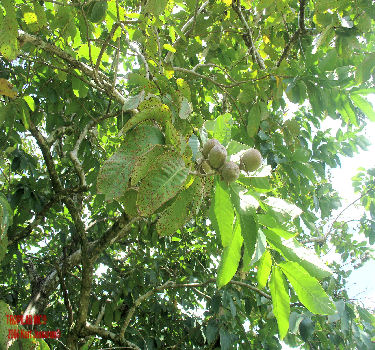 The leaves extract of the Banaba (Lagerstroemis speciosa) is applied against diabetes, obesity,
gout (acute inflammatory
arthritis) and hyperlipidemia (high fat levels in the blood).
The leaves extract of the Banaba (Lagerstroemis speciosa) is applied against diabetes, obesity,
gout (acute inflammatory
arthritis) and hyperlipidemia (high fat levels in the blood). The list goes on and on but for the sake of readability the scope of the plants to be discussed has to be limited though. *Tropical diseases encompass all diseases that occur solely, or principally, in the tropics. In practice, the term is often taken to refer to infectious diseases that thrive in hot, humid conditions, such as malaria, leishmaniasis, schistosomiasis, onchocerciasis, lymphatic filariasis, Chagas disease, African trypanosomiasis, and dengue. (from the W.H.O website) |
Malaria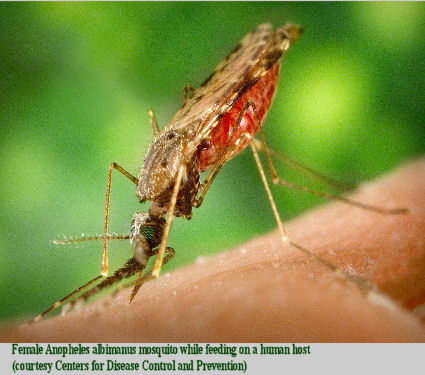 Malaria is one of the most deadly diseases in the world up to this day; The WHO (World Health
Organization) says
that in 2010 there were an estimated 219 million cases of malaria, resulting in
660,000 deaths – 1.2 million deaths. Many
of these were children in Africa.
Malaria is one of the most deadly diseases in the world up to this day; The WHO (World Health
Organization) says
that in 2010 there were an estimated 219 million cases of malaria, resulting in
660,000 deaths – 1.2 million deaths. Many
of these were children in Africa.Malaria is endemic in a broad band around the equator, in areas of the Americas, many parts of Asia, and most parts of Africa. Malaria is a mosquito-borne disease and caused by a parasite. The most deadly of these is known as Plasmodium falciparum. 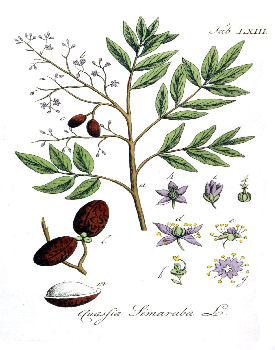 The symptoms are fever, chills, and flu-like illness; if left untreated; patients may develop severe
complications and even
die.
The symptoms are fever, chills, and flu-like illness; if left untreated; patients may develop severe
complications and even
die.Malaria can be prevented and it is treatable. The most effective medicines against this disease are the natural ones. The Amazon rainforerest has many plants that are effective in treating malaria. A few are: Mullaca, Pao Pereira, Quassia, Simarouba, and Spanish cedar. Dengue and Chikungunya 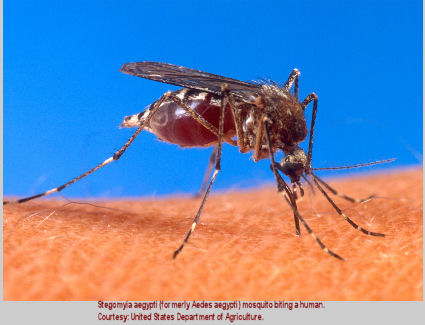 Dengue fever is a tropical disease caused by the dengue virus.
Dengue fever is a tropical disease caused by the dengue virus.This virus (Flavivirus) is spread through the bite of infected mosquitoes (Aedes aegypti and Aedes albopictus species). 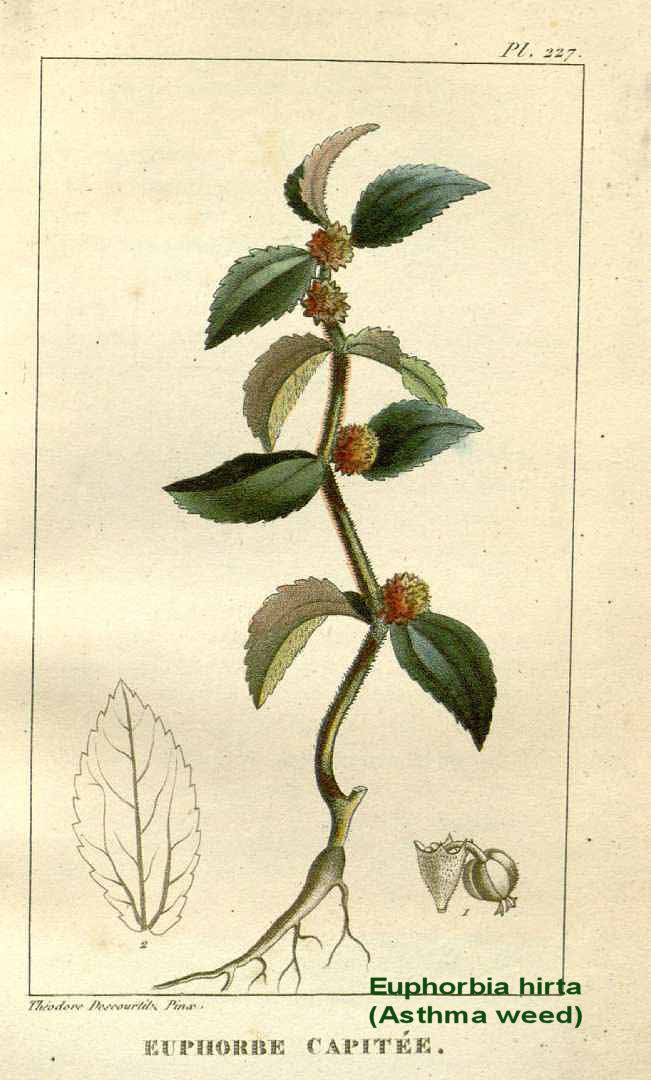 Dengue fever occurs mainly in tropical and subtropical regions; it is common in warm, wet areas.
Dengue fever occurs mainly in tropical and subtropical regions; it is common in warm, wet areas.The number of cases of dengue fever is between 50 and 528 million people infected yearly. 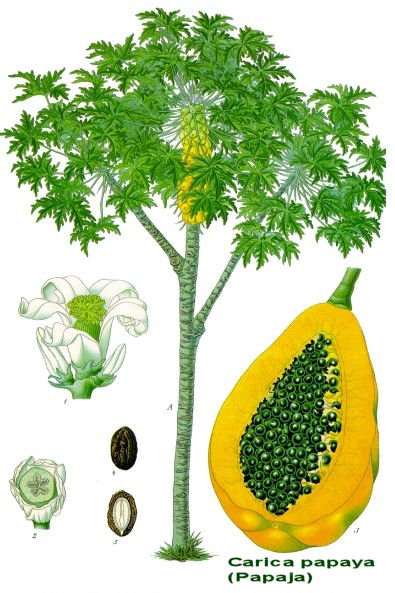 It can cause mild to severe flu-like symptoms and in severe cases this disease can be fatal.
It can cause mild to severe flu-like symptoms and in severe cases this disease can be fatal.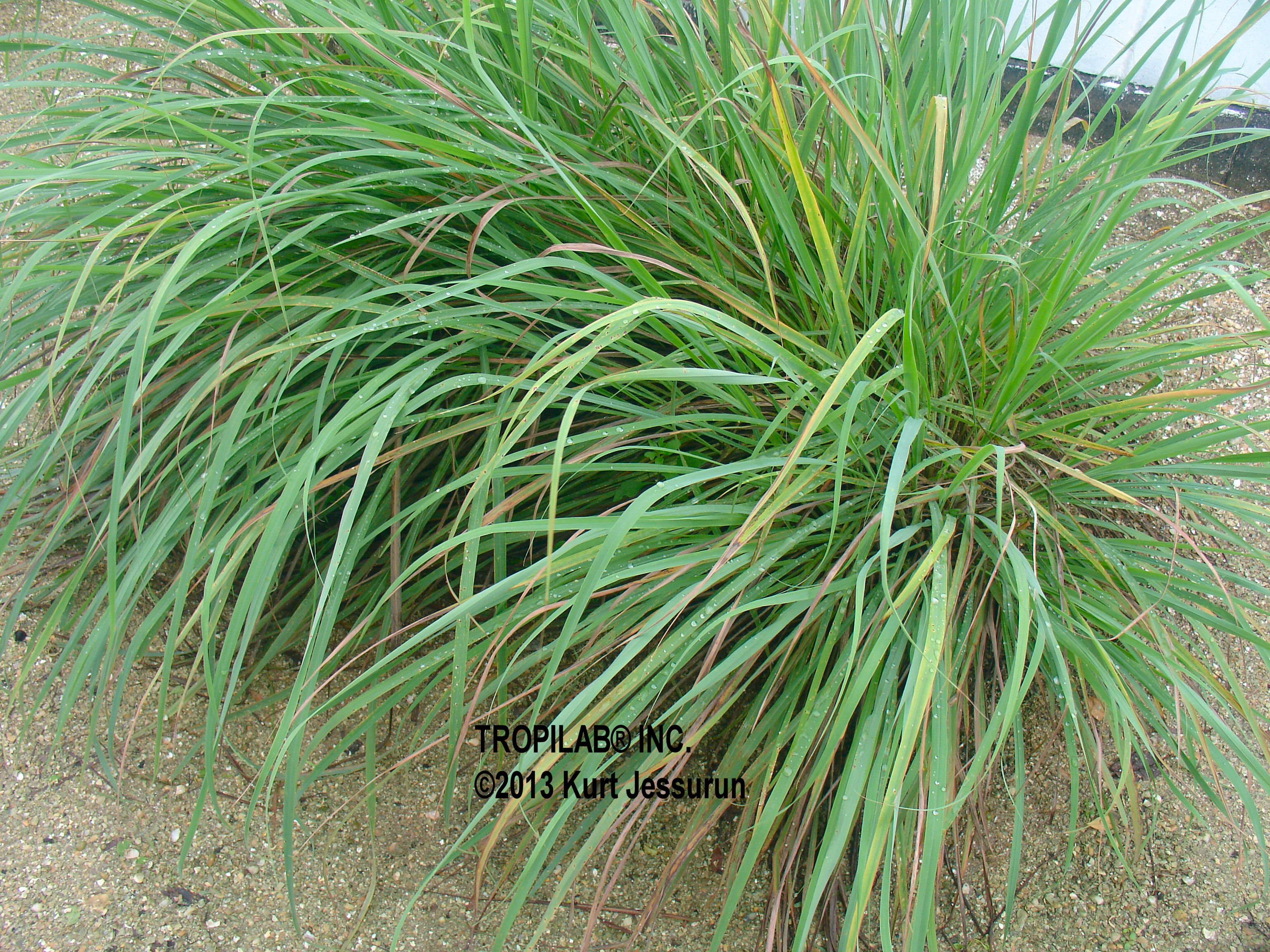 Chikungunya is an infection caused by the Chikungunya virus.
Chikungunya is an infection caused by the Chikungunya virus.This disease is transmitted in the same way as dengue fever to humans by the virus-carrying Aedes mosquitoes. Rodents are also a viral reservoir for this disease; it differs from that of dengue which has only humans and nonhuman primates (monkey’s and apes) as hosts. The common symptoms of this virus infection are: fever and severe joint pain. Other symptoms may include headache, muscle pain, joint swelling, or rash. Most people start to feel better after 7 to 10 days but some people will develop longer term joint pain. Natural ways to treat these diseases are with plants that increase the dwindling platelet count of the blood (Thrombocytopenia), without notable effects in red blood cell- and white blood cell counts. Some of these plants from the Amazon rainforest are: Asthma weed (Euphorbia hirta), Lemon grass (Cymbopogon citratus), and Papaya (Carica papaya). Besides the above mentioned tropical diseases, there are others that are still neglected and for many of them the mainstream western medicine has no real answer to. However, medicinal plants and herbs are available and they can be successfully applied. Besides the tropical diseases mentioned above; a few others are: Trachoma (an eye disease) and Onchocerciasis (river blindness). The TROPILAB® database also contains information about medicinal plants originally from South-east Asia, which are now for many years growing abundantly in Surinam. |
|
The story of Quassi |
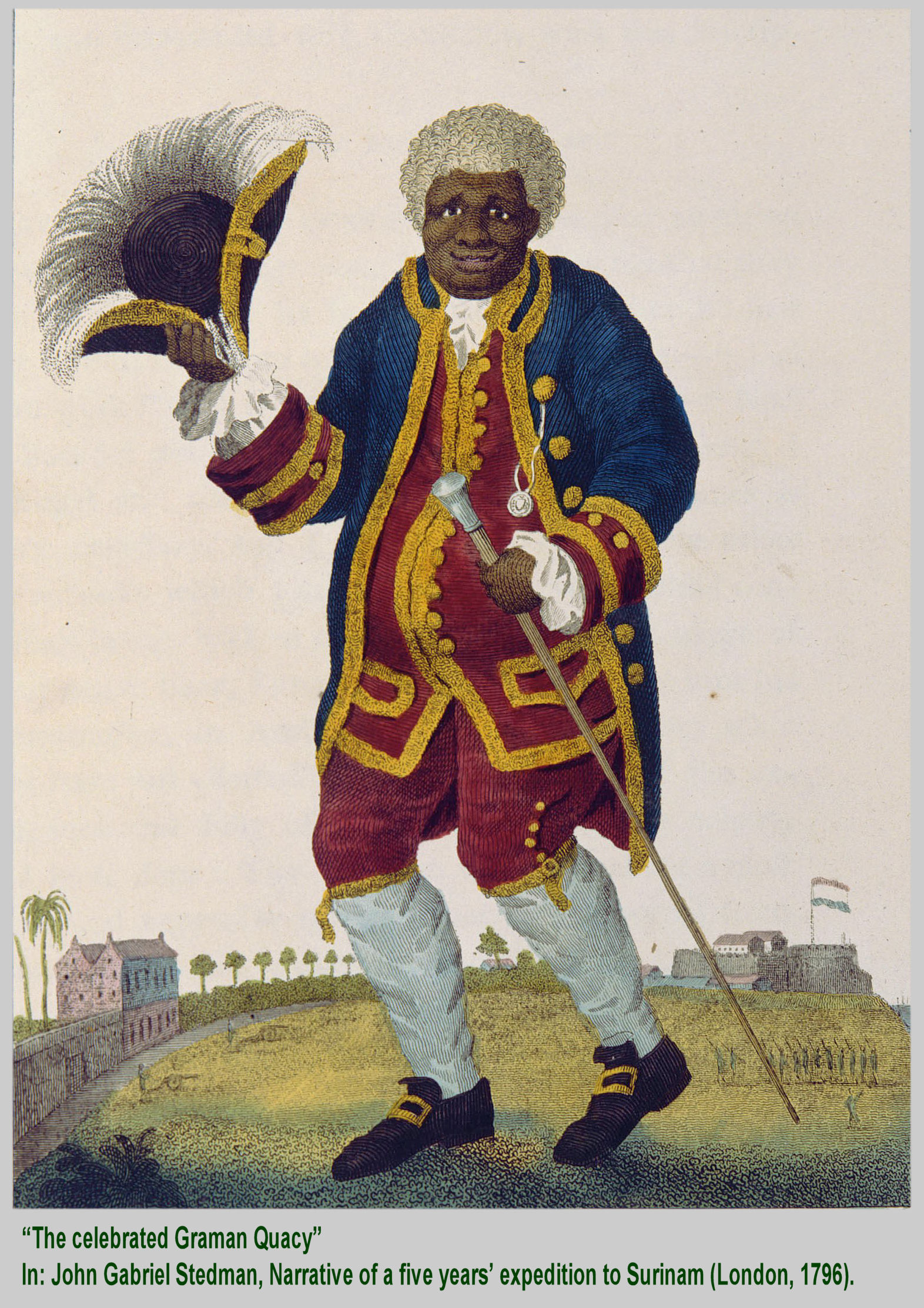 Kwasimukamba or Granman (Grand chief) Quassi, also called Quacy, Kwasi and Quasi,
(1692 - 1780)
was a celebrated Surinamese healer, and botanist. His roots were among the Akan people of
present day Ghana; as a child he
was enslaved and brought to Surinam in the New World. He learned
indigenous medicine from Indians in the Amazon rainforest
and had according to the slaves, the means and
magic powers to heal. He was very often directly consulted, not only by the
slaves, free blacks, and
Indians but also by the white elite and European colonists for their illnesses.
Kwasimukamba or Granman (Grand chief) Quassi, also called Quacy, Kwasi and Quasi,
(1692 - 1780)
was a celebrated Surinamese healer, and botanist. His roots were among the Akan people of
present day Ghana; as a child he
was enslaved and brought to Surinam in the New World. He learned
indigenous medicine from Indians in the Amazon rainforest
and had according to the slaves, the means and
magic powers to heal. He was very often directly consulted, not only by the
slaves, free blacks, and
Indians but also by the white elite and European colonists for their illnesses.His advice was even also sought from Europe, from where he received letters addressed to him as: "The most honorable and most learned gentleman Master Quassi, professor of herbology". He worked as a renowned healer and did this with such a success that he got his freedom. He became a rich man who owned a large plantation. 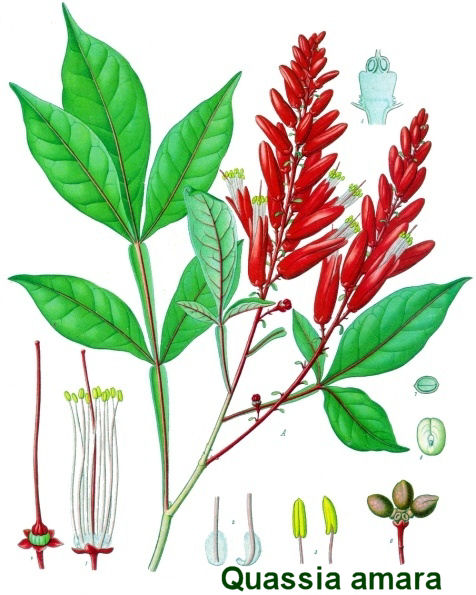 One of his most successful remedies was an extreme bitter tea that he used to treat infections by
intestinal parasites;
malaria and fevers. This was based on the extract of the plant Quassia amara
which
Carolus Linnaeus,
the famous Swedish botanist,
named after him, as the discoverer of its medicinal properties.
One of his most successful remedies was an extreme bitter tea that he used to treat infections by
intestinal parasites;
malaria and fevers. This was based on the extract of the plant Quassia amara
which
Carolus Linnaeus,
the famous Swedish botanist,
named after him, as the discoverer of its medicinal properties.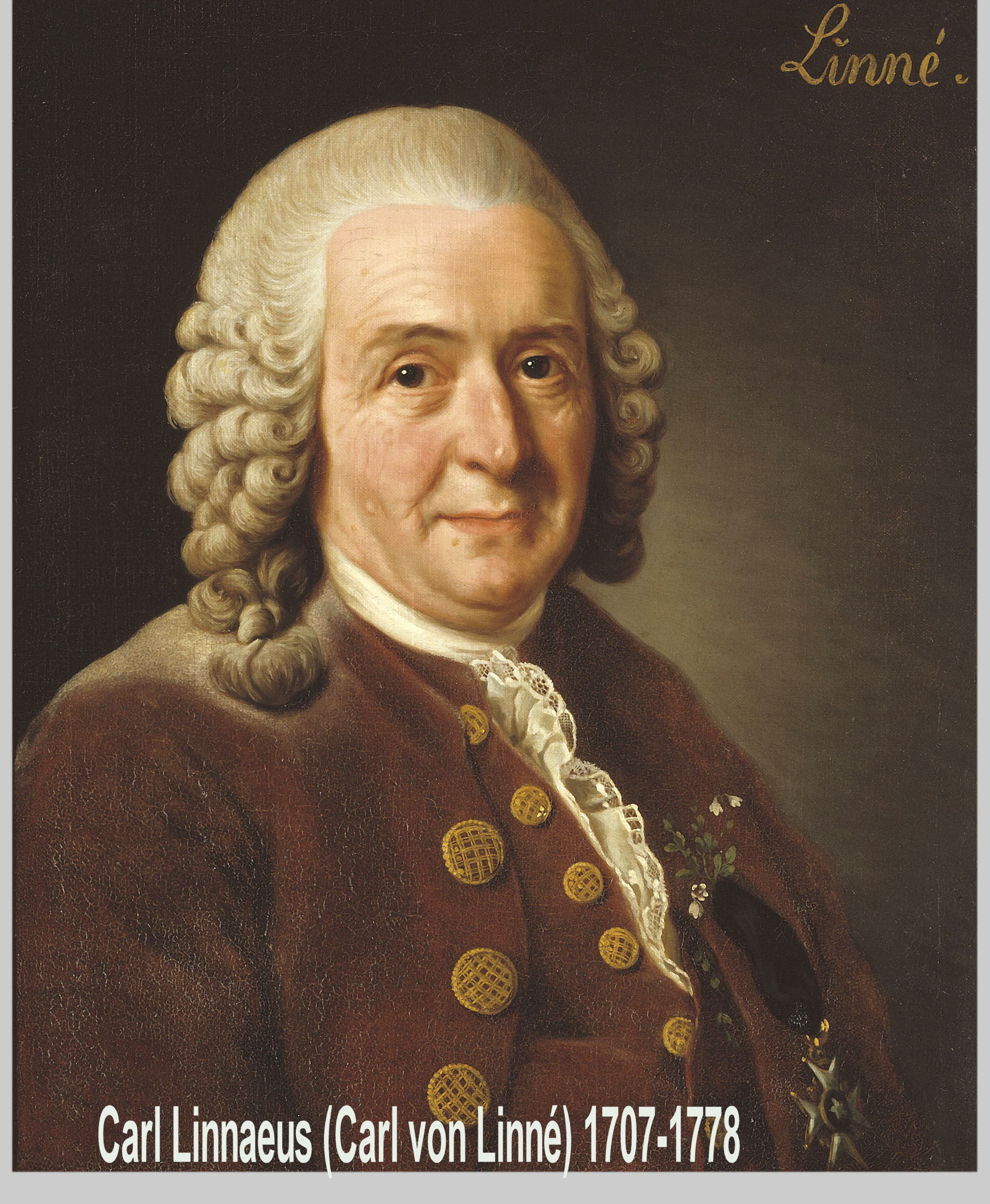 He was sometimes referred to as "Professor of Herbology in Surinam" and was presented to Prince
Willem V of Orange,
Stadtholder (chief executive) of the Dutch Republic, in The Hague in 1776.
He was sometimes referred to as "Professor of Herbology in Surinam" and was presented to Prince
Willem V of Orange,
Stadtholder (chief executive) of the Dutch Republic, in The Hague in 1776.From the mid-18th century Quassia amara began to appear in western pharmacopeia. Quassia is still used today; as a natural insecticide, in herbal medicine (digestive aid, liver & gallbladder problems) and as an additive in the food industry. |
| (Chapter one) |
| THE FUTURE OF MEDICINE |
| Persistent health problems at the start of the 21st century
|
|
It is obvious that many health problems still exist today
and there is a need for newer, more effective
drugs with far less dangerous side effects that the flood of drugs, many with
exotic commercial names, that are
used today. They also work more on the symptoms than on the root cause of the (health) problem. There is an urgent need to utilize plants, fungi and molds that were used for centuries by traditional healers.  However there are unfortunately also other factors to take into account such as the state of the health care systems in
the
developed world (rich countries) and Third World (poor
countries). Both face major but different challenges.
However there are unfortunately also other factors to take into account such as the state of the health care systems in
the
developed world (rich countries) and Third World (poor
countries). Both face major but different challenges.Even in the most developed countries, such as the USA, access to quality care is outrageous expensive, while in the Third World many people have no access to whatever system at all. Partly due to this reason, epidemic and pandemics often starts in underdeveloped countries in Africa. The rapid growing world population, especially in the Third World, is also a very worrying situation that needs to be addressed. People in these countries are for a great part only served by local healers working with medicinal plants and herbs gathered in the vicinity from where they practice. 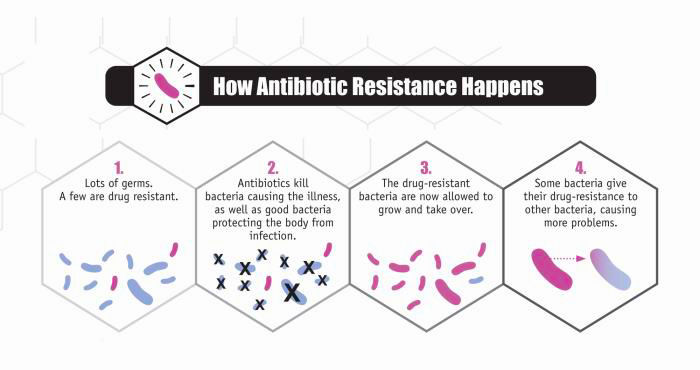 Other specific problems such as the overuse of antibiotics resulting in resistance of bacteria against these are
another
world-wide problem.
Other specific problems such as the overuse of antibiotics resulting in resistance of bacteria against these are
another
world-wide problem.Each year in the United States alone, at least 2 million people acquire serious infections with bacteria that are resistant to one or more of the antibiotics designed to treat those infections. At least 23,000 people die each year as a direct result of these antibiotic-resistant infections. Many more die from other conditions that were complicated by an antibiotic- resistant infection. The overuse of antibiotics is the single most important factor leading to antibiotic resistance around the world. Antibiotics are among the most commonly prescribed drugs used in human medicine. However, up to 50% of all the antibiotics prescribed for people are not needed, or are not optimally effective as prescribed. Antibiotics are also commonly used in food for animals to prevent, control, and treat diseases, as well to promote the growth of food-producing animals. (CDC/ Melissa Brower). The WHO cautioned in a 2014 report: A post-antibiotic era -- in which common infections and minor injuries can kill, far from being an apocalyptic fantasy, is instead a very real possibility for the 21st century. According to the CDC,1 in 3 antibiotic prescriptions are unnecessary.  “Antibiotics are lifesaving drugs, and if we continue down the road of inappropriate use we’ll lose the most powerful tool we have to
fight life-threatening infections,” said CDC Director Tom Frieden, M.D., M.P.H. “Losing these antibiotics would undermine our ability to
treat patients with deadly infections, cancer, provide organ transplants, and save victims of burns and trauma.”
“Antibiotics are lifesaving drugs, and if we continue down the road of inappropriate use we’ll lose the most powerful tool we have to
fight life-threatening infections,” said CDC Director Tom Frieden, M.D., M.P.H. “Losing these antibiotics would undermine our ability to
treat patients with deadly infections, cancer, provide organ transplants, and save victims of burns and trauma.”Antibiotics These are chemical compounds that inhibit the growth of microorganisms. Most antibiotics are only anti-bacterial and do not have activity against viruses, fungi and other microbes. They also kill friendly bacteria in the colon. Ancient healers were keenly aware of certain substances having antibiotic properties; however they did not understand what caused infection. It was not until the start on the 19th century that mankind knew that bacteria were the culprit. One of the first natural medicines was used by the ancient Egyptians. It was a mixture of lard, honey and lint that was pressed into wounds. Enzymes found in the honey converts glucose and oxygen together into hydrogen peroxide, a very well known disinfectant. We now know that honey also kills the bacteria by drawing water out of them. In the Dark Ages in Europe, moldy bread was used on wounds to heal or prevent infection. The use of molds (or moulds) was also practiced in China and India. Penicillin, one of the first modern (natural) antibiotics was isolated from a piece of moldy bread. This "discovery" did not happen until 1928. 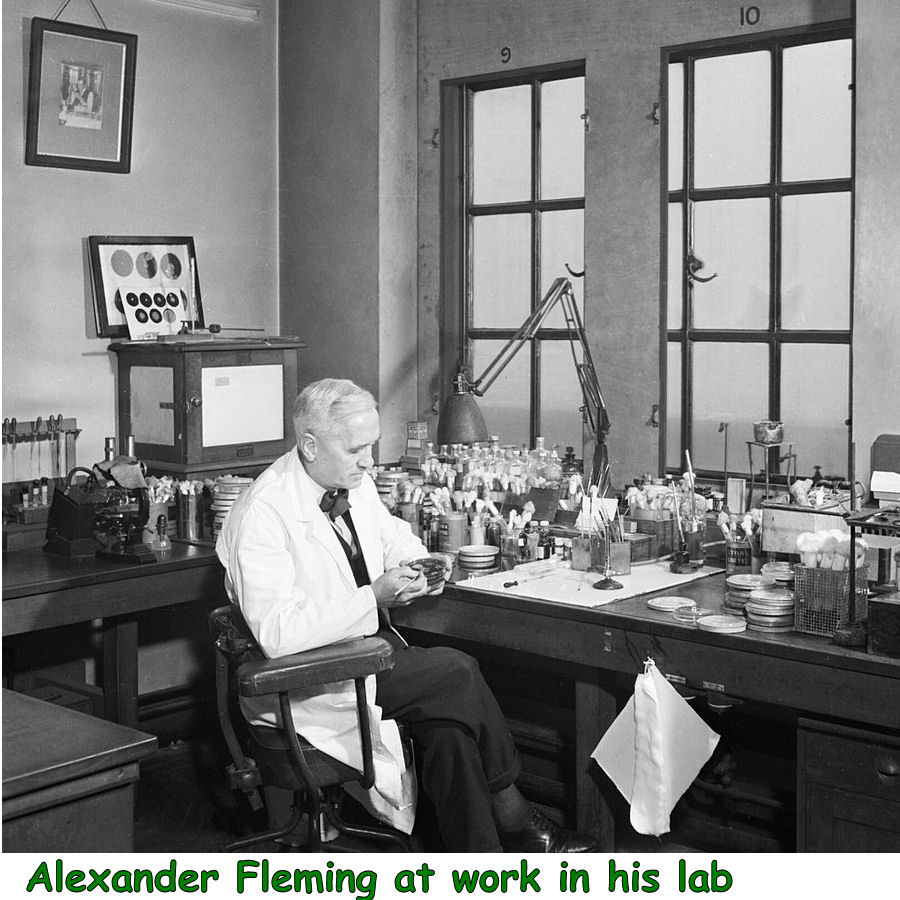 Alexander Fleming (1881-1955) was the first to suggest that the Penicillium mold secreted an antibacterial substance and
was also first to concentrate this active substance; he called it Penicillin.
Alexander Fleming (1881-1955) was the first to suggest that the Penicillium mold secreted an antibacterial substance and
was also first to concentrate this active substance; he called it Penicillin.Prescribed antibiotics kill all bacteria and do not discriminate between good and the bad one. This leaves the body stripped of its natural ability to fight infection and ward off illnesses and diseases. Shamans and other traditional healers in the Amazon rainforest use a variety of molds, not known to modern science, to treat - and prevent certain infections. Take garlic for instance; it contains many antioxidants and is perfectly suited to protect against cough, cold and flu. Garlic has the compound Allicin, that has excellent anti-bacterial, anti-viral and anti-fungal properties.  Other favorites of herbalist are without doubt Cat’s claw (Uncaria guianensis & tomentosa).
Other favorites of herbalist are without doubt Cat’s claw (Uncaria guianensis & tomentosa).They are very effective in fighting internal inflammations. 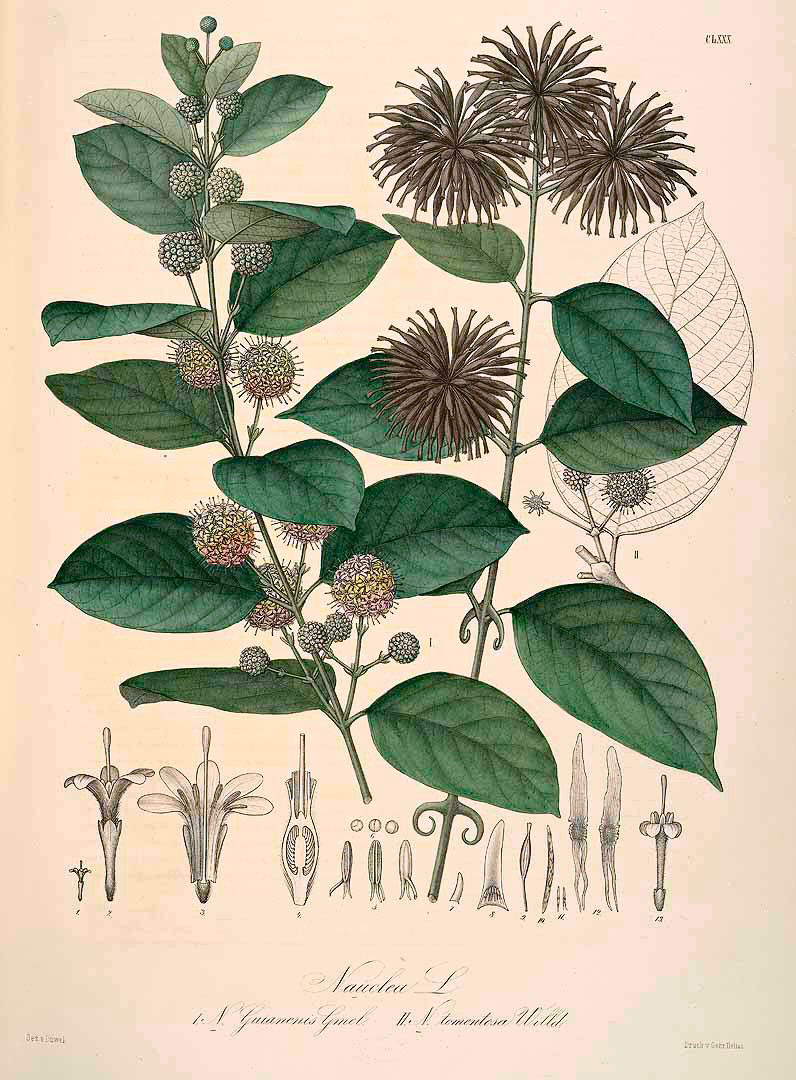
Other challenges Many more challenges also still remain to be addressed. Diabetes, high blood pressure and cholesterol are nowadays almost pandemics! There are many allopathic (western) drugs out there to be used against these illnesses. Most of them though are expensive and often not very effective; some even may have serious side effects. 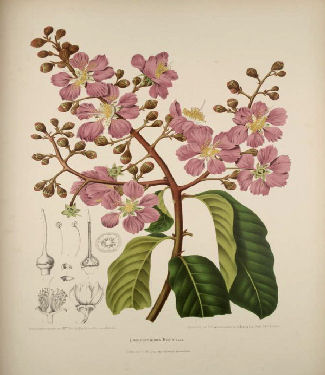
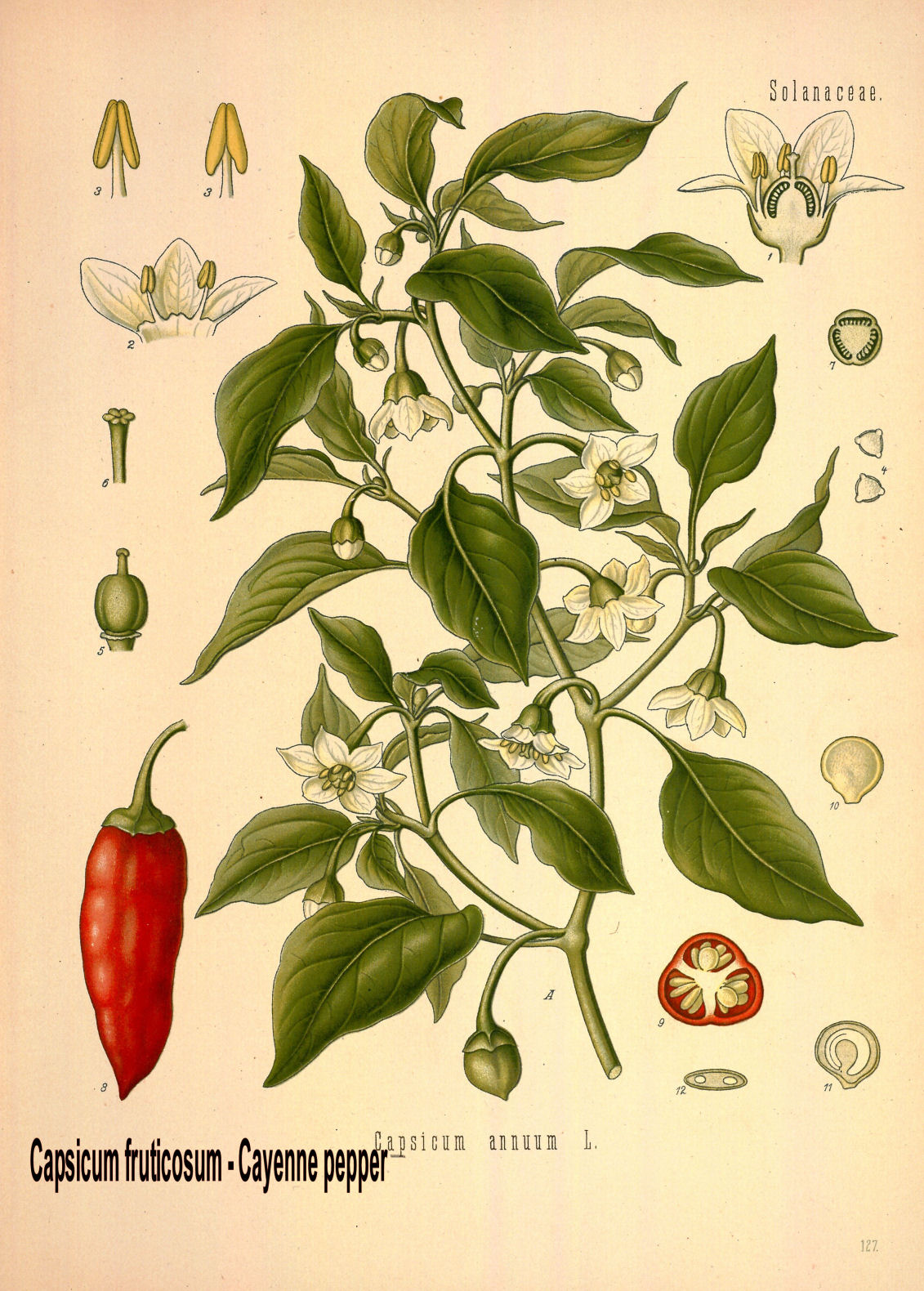 Luckily there are many botanicals available that can do the job just as good without the high price tag attached to them and even more
important; without these side effects. Just to name a few in this context: Banaba (Lagerstroemia speciosa) against diabetes and
high triglycerides, Cayenne (Capsicum frutescens) against elevated blood pressure.
Luckily there are many botanicals available that can do the job just as good without the high price tag attached to them and even more
important; without these side effects. Just to name a few in this context: Banaba (Lagerstroemia speciosa) against diabetes and
high triglycerides, Cayenne (Capsicum frutescens) against elevated blood pressure.
Treatment with natural medicine 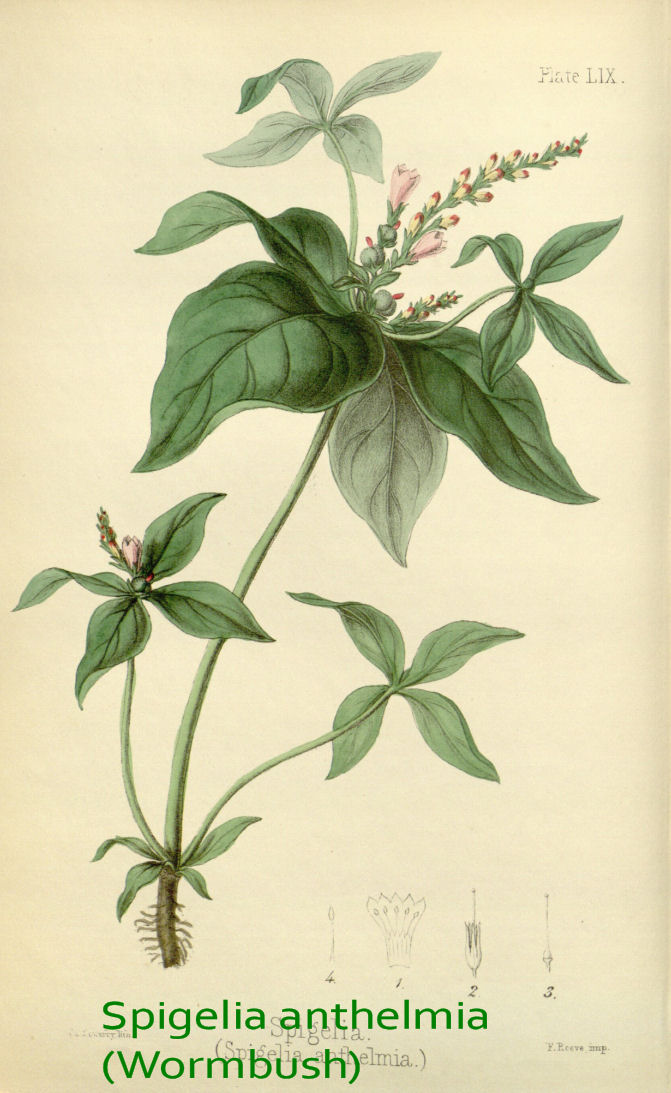 Although botanicals are generally safe and have as said, far fewer side effects, remedies from botanicals are powerful and some may even
be very toxic.
Although botanicals are generally safe and have as said, far fewer side effects, remedies from botanicals are powerful and some may even
be very toxic.One should not presume that since a product comes from nature it must be naturally safe; powerful natural poisons within the plant like atropine and nicotine belie this. 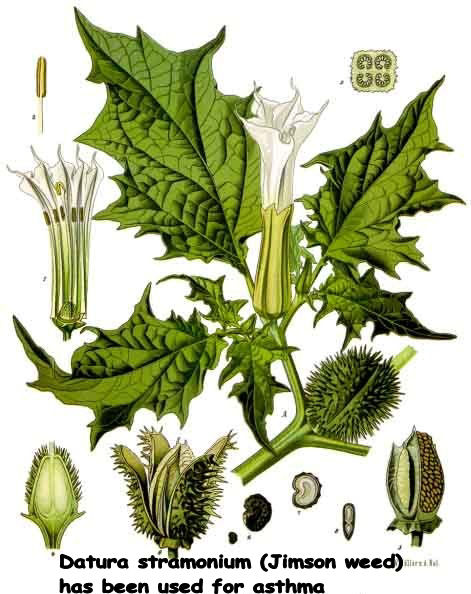 Datura stramonium (Jimson weed) has been used for asthma, because it contains the alkaloid atropine, but it is also a
powerful and potentially fatal hallucinogen.
Datura stramonium (Jimson weed) has been used for asthma, because it contains the alkaloid atropine, but it is also a
powerful and potentially fatal hallucinogen.There may be also undesirable reciprocal interactions between botanicals and allopathic drugs. Another exemple; Spigelia anthelmia (Demerara pinkroot) is a very poisonous plant but when applied by a qualified homeopathic, it exerts a powerful action on the nervous system. It also has an important role in cardiac treatment and it is a major drug for pericarditis (inflammation of the pericardium). 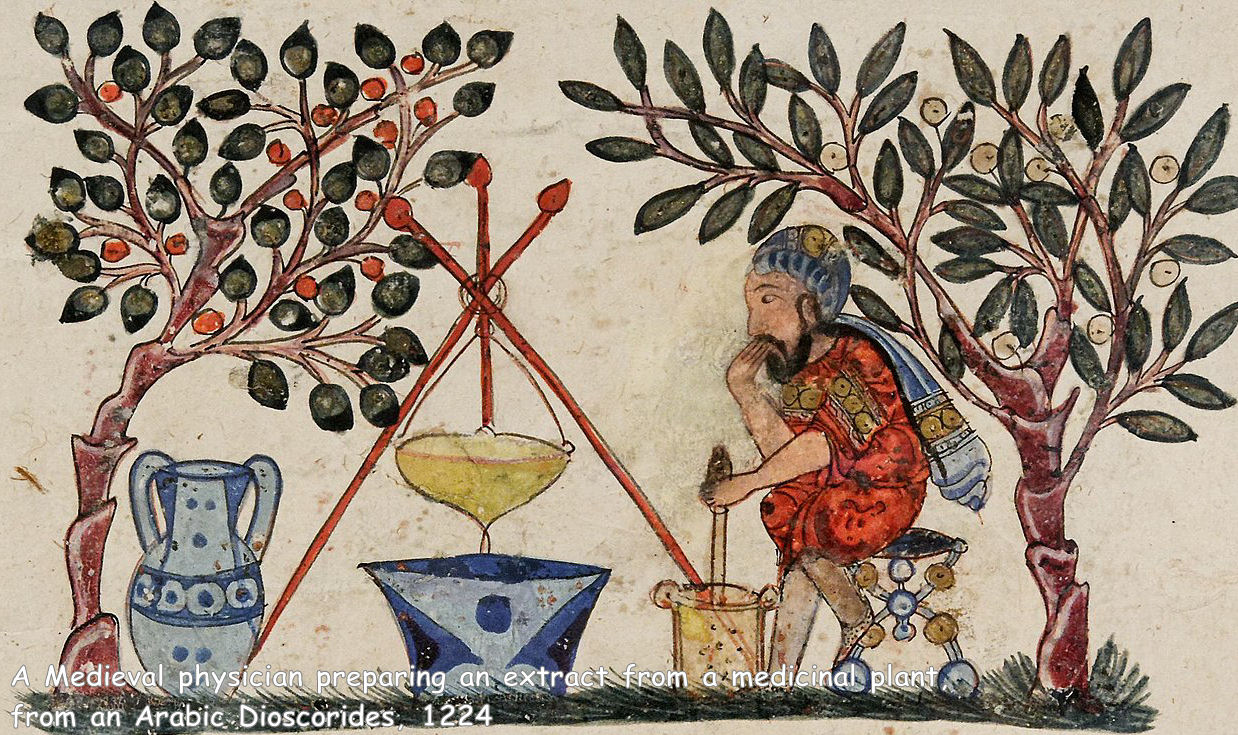
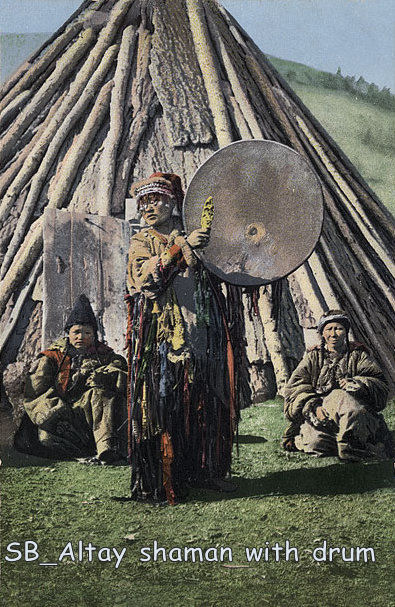 Shamans and other health practitioners specialized in this field, in general know how to effectively and safely use these botanicals.
Shamans and other health practitioners specialized in this field, in general know how to effectively and safely use these botanicals.The majority of medical doctors though has not been taught in depth, if at all, about the use of medicinal plants and often consider themselves not qualified to give patients the right advice. Fortunately though, these days there is an upward trend to train more specialists in the science of alternative medicine who are indeed qualified to give the right advice to patience for the use and treatment of botanicals against their health problems. |
Disclaimer: |